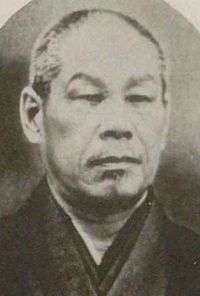Tachibana Koichirō
| Tachibana Koichirō | |
|---|---|
|
General Tachibana Kōichirō | |
| Native name | 立花小一郎 |
| Born |
20 March 1861 Ōmuta, Fukuoka, Japan |
| Died | 15 February 1929 (aged 67) |
| Allegiance | Empire of Japan |
| Service/branch |
|
| Years of service | 1883 - 1923 |
| Rank | General |
| Battles/wars | |
Baron Tachibana Koichirō (立花小一郎, 20 March 1861 – 15 February 1929) was a general in the early Imperial Japanese Army, and later a politician in the Diet of the Empire of Japan.[1][2]
Biography
Tachibana was born as the eldest son to a samurai family in Miike Domain (present day Ōmuta, Fukuoka). In December 1883 he entered sixth class of the predecessor of the Imperial Japanese Army Academy and was commissioned as a second lieutenant in the fledgling Imperial Japanese Army. He graduated with honors from the 5th class of the Army Staff College in December 1889 and was assigned to the Imperial Japanese Army General Staff Office. During the First Sino-Japanese War, Tachibana served on the staff of the Japanese First Army. After the end of the war, from 1896 to 1899, he was sent to Austria-Hungary for training.[1]
On his return, Tachibana was assigned to the Japanese China Garrison Army, becoming a military advisor to Yuan Shikai.[3] On his return to Japan, he became the bureau head of the Personnel Department of the Ministry of War of Japan.
With the start of the Russo-Japanese War, Tachibana deputy chief-of-staff of the Japanese Fourth Army under General Nozu Michitsura. In March 1905 he was promoted to colonel and was ordered back to Japan shortly after the Battle of Mukden to serve on the staff of the Imperial General Headquarters. He was one of the representatives from Japan at the Treaty of Portsmouth negotiations ending the war, later remaining as a military attaché to the United States.[1]
In August 1908, Tachibana was promoted to major general and commanded the IJA 22nd Infantry Brigade, followed by the IJA 30th Infantry Brigade and the 1st Brigade of the Imperial Guards. He was subsequently chief-of-staff of the Japanese Chosen Army and head of the Kempeitai under the Chosen Government-General. In August 1914, Tachibana was promoted to lieutenant general. He then commanded the IJA 19th Infantry Division, the IJA 4th Infantry Division and was the first commander-in-chief of the newly formed Kwantung Army from 1919 to 1921.[4]
In August 1920, Tachibana was promoted to general and from January 1921 to November 1922 was appointed the final commander-in-chief of the Japanese expeditionary force in the Japanese intervention in Siberia. Afterwards, he served on the Supreme War Council (Japan). He entered the reserves in March 1923, and was ennobled with the title of baron (danshaku) under the kazoku peerage system in October of the same year.
From August 1924 to August 1925, Tachibana served as mayor of the city of Fukuoka. From July 1925 to his death in February 1929, he held a seat in the House of Peers in the Diet of Japan.
References
- Kowner, Rotem (2006). Historical Dictionary of the Russo-Japanese War. ISBN 0-8108-4927-5: The Scarecrow Press.
- Dunscombe, Paul E (2011). Japan's Siberian Intervention, 1918–1922:. Lexington Books. ISBN 0739146025. page 146
Notes
- 1 2 3 Kowner, Historical Dictionary of the Russo-Japanese War, p. 364-365.
- ↑ "Tachibana Koichirō". Nihon jinmei daijiten+Plus (in Japanese). Kōdansha. Retrieved 16 May 2014.
- ↑ Reynolds, Douglas R. (1995). China, 1895-1912 State Sponsored Reforms and China's Late-Qing Revolution. ISBN 1563247496: M E Sharpe. page 78
- ↑ Coox, Alvin D. (1985). Nomonhan: Japan Against Russia, 1939. ISBN 0-8047-1160-7: Stanford University Press. page 7
